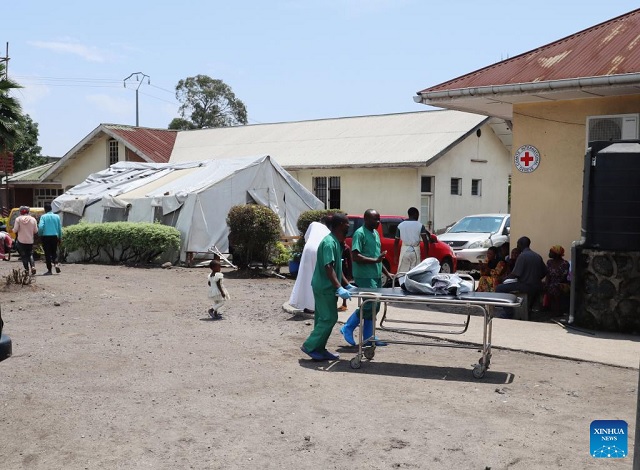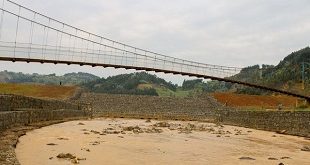
GOMA, DR Congo | Xinhua | As clashes escalate between the military and armed rebels in the eastern part of the Democratic Republic of the Congo (DRC), Goma, the main city in the region, has been beset by an influx of civilians into displacement camps, and its healthcare facilities are overwhelmed by the continuous influx of the injured.
At the CBCA Ndosho Hospital, the best-equipped in Goma, the capital of North Kivu Province and also a strategic and commercial city in the Great Lakes region of Africa, doctors and nurses are tirelessly working, 24/7, to face this growing health crisis, exacerbated by the recent offensives by rebels of the March 23 Movement (M23) in the town of Sake and its surroundings. Sake is located about 27 km northwest of Goma.
At the triage under the coordination of the International Committee of the Red Cross (ICRC), healthcare workers were attending to several emergency cases, with cries of pain echoing in the corridor and a continuous arrival of the injured, transferred by motorbikes from the conflict-stricken areas indiscriminately bombed by the M23 rebels for weeks.
“We are overwhelmed by the current situation in our facility. In Goma, we have never seen anything like this before. This situation is unique under the current circumstances,” said Laurent Cresci, the head nurse of the surgical team of the ICRC in Goma, with a fatigued expression in the emergency room where his team operates day and night.
According to Cresci, with about 20 operations daily, almost 90 percent of the patients in this healthcare facility are victims of the ongoing clashes in North Kivu Province, particularly in Sake, where the fighting between the Congolese military and the M23 has been raging since last week.
Sake is considered the last barrier before Goma. Once Sake falls into the hands of the M23, the city of Goma would be completely isolated except for Lake Kivu. In late 2012, Goma was briefly occupied by the M23 before being militarily defeated the following year.
Since Monday of last week, at least 76 other injured individuals have been transferred to the hospital, some with serious gunshot wounds, said the ICRC Thursday, expressing concern about the risk of the local healthcare system breaking down with the escalation of violence around Goma.
“We have treated over 318 injured individuals since the beginning of the year 2024, whereas our initial capacity is 64 beds … The lack of space to accommodate so many patients is our main challenge,” Cresci said.
SCENES OF TRAUMA
Several patients share a narrow bed, with their bandages stained with blood after receiving medical care, while others are still waiting for their turn for an operation. It is in this overcrowded room that the injured share scenes of suffering.
Mupenzi Nzitonda, 19, sitting on the bed with a serious back injury, is one of the victims of the attack on Feb. 7 when the M23 rebels bombed Sake. Still recovering from several bullet shots on his back, he said that he temporarily sought refuge in Sake with his family after leaving his home in Karuba, a village now under M23 occupation.
“We found ourselves between two explosions (of bombs),” he recalled.
It is the same case for Riziki Sengihuva, originally from Karuba, who had one of her legs pierced by bomb shrapnel fired at her shelter in Sake. After being transported to the hospital by volunteers, medical staff managed to control her pain and put her leg back in place despite losing several nails.
According to the United Nations High Commissioner for Refugees (UNHCR), since the first week of February 2024, at least 15 civilians have been killed and 29 injured around Goma and Sake. The UNHCR estimated that around 135,000 internally displaced persons have fled Sake to Goma, putting pressure on the city, which already has a population of about two million.
“We were all outside the house, and the little girl was inside the house when a bomb fell on our house. Unfortunately, the girl was severely wounded by bomb shrapnel,” confided a mother who fled Sake, sitting on a bed next to her daughter, who was injured in the leg and head during the attack.
Since the escalation of hostilities and the M23’s advance into the territory of Masisi in North Kivu, healthcare institutions, where conflict-displaced people seek refuge, have been severely exposed to crossfire during the deadly clashes over the past few months.
“The situation is extremely worrisome. The hospital is overwhelmed, with thousands of people crammed inside, trying to find some protection from the fighting,” lamented Caglar Tahiroglu, project coordinator for Doctors Without Borders (MSF) in Mweso, one of the centers of violent clashes.
GOMA ON THE VERGE OF SUFFOCATION
With the main roads between Goma and its surroundings cut off by the M23, the city of Goma is on the verge of economic suffocation, while the situation remains highly volatile on the frontline. It is holding on with the influx of civilians into displacement camps, which risks worsening the already precarious humanitarian crisis, with the supply of goods heavily cut off and suffocated by the M23’s advance.
“I fear a major famine for the city of Goma. You see, these are people (the displaced) coming from regions that do agriculture for Goma. Since Goma is now enclosed, we fear widespread famine in Goma,” said Jacinthe Maarifa, a volunteer with the organization “Agir RDC.”
For over a week, fighting has been raging in Sake, with several attempts by M23 rebels to take control of Sake, but thwarted by the Congolese army with the support of military elements from the Southern African Development Community (SADC). During the night from Tuesday to Wednesday, despite being repelled, the rebels still control the hills overlooking Sake.
Deputy Prime Minister in charge of Defense Jean-Pierre Bema stressed Wednesday that everything had been done to secure the victory of this war. Hundreds of additional soldiers have still been sent to Goma since last week by Kinshasa, which has rejected any dialogue with the M23 rebels.
In the offensive against the rebels in Sake, two South African soldiers deployed as part of the SADC force have been killed, according to military authorities in a statement released Thursday.
 The Independent Uganda: You get the Truth we Pay the Price
The Independent Uganda: You get the Truth we Pay the Price


